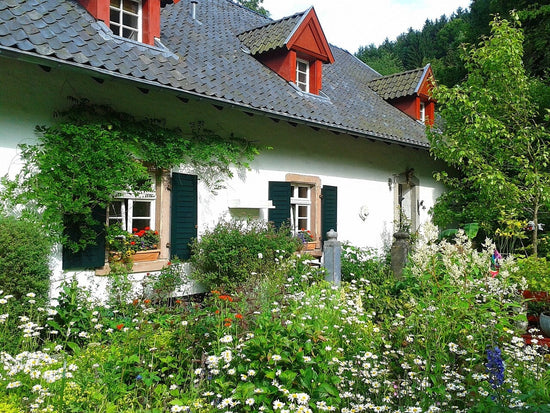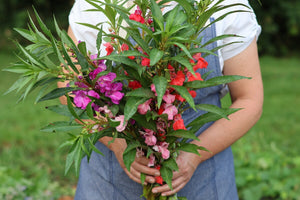Hollyhocks from Seed: The Perfect Addition to Your Cottage Garden
Do you love cottage gardens? Then you’ll need plenty of hollyhocks! These tall biennials are the iconic flowers for cottage and country-style gardens. We’ll explain the step-by-step process of growing hollyhocks from seed so you can enjoy their beauty year after year.

How to Grow Hollyhock Flowers From Seed
Hollyhocks have been cultivated for centuries and are native flowers in Asia and Europe. Often towering over 6 feet tall, they have sturdy, hairy stems adorned with large, showy flowers. Their height makes them perfect for lining a fence or garden shed.
With their characteristic charm, hollyhocks have become iconic plants in cottage and country-style gardens, adding a touch of old-world elegance to any space. Hollyhocks can come in different colors and are single or double bloom.
They are known for attracting pollinators like bees and butterflies, further enhancing the natural beauty they bring to a garden. Bees are especially drawn to the single-petal variety.
Whether grown along fences, in borders, or as dramatic accents, hollyhocks will captivate and enchant you with their distinctive, majestic appearance.

Growing Hollyhocks from Seed
Planting hollyhock seeds is an easy way to start growing hollyhock flowers. Seeds can be sown indoors or out. Plan to nurture your hollyhock seedlings for a season before they start blooming.
To give hollyhock plants a longer growing season, start seeds indoors 6 to 8 weeks before the last spring frost.
Wait until all danger of frost has passed before direct sowing hollyhock seeds outdoors.
Choose a sunny location with well-draining, fertile soil.
Tips for fail-proof Hollyhock seed germination
Sow hollyhock seeds ¼” deep in seed starting mix
Mist soil and keep the seeds moist. A humidity dome will help.
Keep the soil temperature at 60 to 70ºF.
Seeds should germinate in 10 to 14 days.
Harden off seedlings before transplanting outdoors. Hollyhock flowers have a long tap root and may need to be potted up before they are ready for outdoor life.
Space hollyhock seedlings 18 to 24 inches apart.
How to Grow Hollyhock Flowers
There are several things to keep in mind when deciding where to grow hollyhock flowers. Choosing the appropriate location will make them a more welcome part of your garden.
Because they are so tall, hollyhocks are excellent flowers along fences and in the back of a cottage garden. Fences and walls can help keep them up, but they may need staking in windy locations.
Another consideration for location is that hollyhocks are biennial flowers. Plan on being patient to help them get off to a good start in the first year. Once you have hollyhocks established in your flower garden, you will be richly rewarded. They will self-seed and come back each year.

Sun
Hollyhocks can grow in full sun to part shade. However, they will be taller and produce more blooms when they have at least 8 hours of direct sun.
Soil
Hollyhocks are fairly adaptable to whatever soil they are grown in. But for best flowering and healthy growth, plant hollyhocks in well-draining, fertile soil with a pH between 6 and 8.
Fertilizing
Applying well-rotted compost in the spring can keep the soil fertile for continued healthy growth.
Water
When hollyhock plants are small, they will need more frequent watering. Once the plants are established, they should have long tap roots and be drought-resistant. Hollyhocks can suffer fungal diseases if they are kept too wet, so use watering methods that keep the leaves dry while getting water to the roots.

Solutions for hollyhock pests and diseases
Hollyhocks have their own special fungal infection called hollyhock rust. It first shows up as yellow spots. If you check the underside of the leaves, you’ll see orangish-brown blisters. Remove affected leaves to keep it from spreading. If infected leaves are left on the ground, the fungus will come back next year. Other control methods include keeping weeds away and using effective watering to get water to the roots while keeping the plants dry. In humid locations, it’s important to give hollyhock plants enough space for airflow so they can air out.
You can learn more about Hollyhock Rust in this article by the Wisconsin Horticulture Division of Extension.
https://hort.extension.wisc.edu/articles/hollyhock-rust/

Harvesting Hollyhocks
Hollyhocks are considered a summer flower and typically bloom from June to September. With a little extra care, they can be cut and enjoyed indoors.
In a cottage or wildflower garden, hollyhocks are allowed to grow and go to seed. When the flowers die off, the seeds will fully develop and fall to the ground. As long as birds or other critters don’t eat them, they will sprout and grow flowers the following year.
Cut back hollyhock plants in the winter and apply a layer of straw or mulch so they can regrow in the spring.

Hollyhock FAQs
Can hollyhocks be used as a cut flower?
Hollyhocks can be used as cut flowers. Searing is a technique that can significantly improve their vase life. When they are cut, hollyhocks release a healing sap that prevents them from taking up water. Searing the ends of the stems allows the water to get inside. Read more about maximizing the vase life of flowers.
How long will hollyhock flowers last in a vase?
Hollyhock flowers will last 10 to 15 days in a vase. The buds will continue to open.
Are hollyhocks deer resistant?
In my experience, deer will eat the young plants. It is best to protect them from deer.
If you’re a flower gardener who appreciates the beauty of classic cottage garden favorites, then hollyhocks are a must-have. Imagine the lush and vibrant blooms swaying in the breeze, adding a touch of nostalgia and beauty to your outdoor space.
Order your hollyhock seeds today and bring a touch of old-fashioned charm to your garden!







Catherine – Uggh! Hollyhock Rust is no fun. You are doing the right thing to remove all affected plants to keep it from spreading. The fungus can survive the winter, so you will also want to remove all hollyhock debris in the fall. If you have seeds that haven’t been affected, then they will be okay to plant. However, if there’s a chance they have spores on them, they will continue to spread the fungus.
Hello, I just discovered that my Hollyhocks are have the “rust” disease.
So I will remove them all.
Does this mean that all the seeds & blooms on the stalks are not viable to transplant now! Some
of them have not been affected yet, so I’ll assume planting them else where will be okay. Right?
I eagerly await your response .
Thanks.
Catherine Crawford
Leave a comment